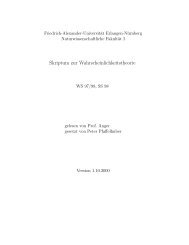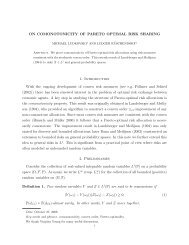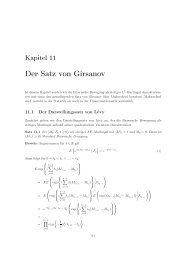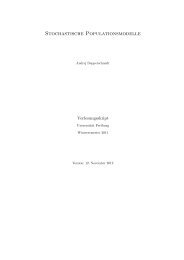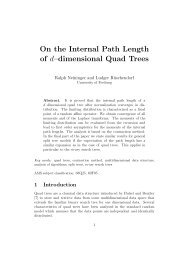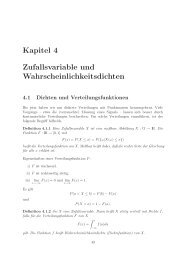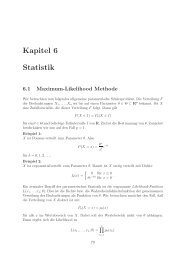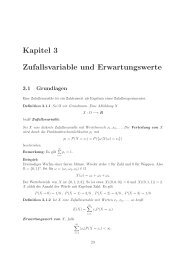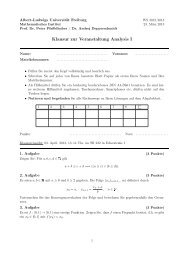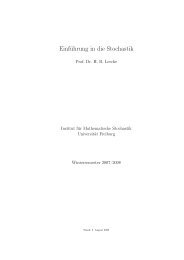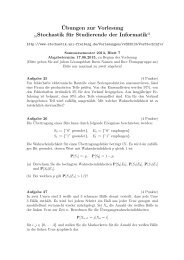Analysis of Markov chain algorithms on spanning trees, rooted ...
Analysis of Markov chain algorithms on spanning trees, rooted ...
Analysis of Markov chain algorithms on spanning trees, rooted ...
You also want an ePaper? Increase the reach of your titles
YUMPU automatically turns print PDFs into web optimized ePapers that Google loves.
J. Fehrenbach and L. Rüschendorf 5<br />
In fact they c<strong>on</strong>sidered an extensi<strong>on</strong> <str<strong>on</strong>g>of</str<strong>on</strong>g> the problem to matroids which satisfy<br />
a certain balance-c<strong>on</strong>diti<strong>on</strong>. Since for a graph G = (V, E) the pair M =<br />
(E, ST(G)) – ST(G) the set <str<strong>on</strong>g>of</str<strong>on</strong>g> <strong>spanning</strong> <strong>trees</strong> <str<strong>on</strong>g>of</str<strong>on</strong>g> G – is a graphical matroid<br />
satisfying this balance c<strong>on</strong>diti<strong>on</strong>, the <strong>spanning</strong> tree problem is included in<br />
their result. In a recent paper Jerrum and S<strong>on</strong> (2002)found a bound for the<br />
log Sobolev c<strong>on</strong>stant which leads to an improvement <str<strong>on</strong>g>of</str<strong>on</strong>g> the Feder and Mihail<br />
mixing result <str<strong>on</strong>g>of</str<strong>on</strong>g> the bases exchange walk for balanced matroids to the order<br />
O(nm log n).<br />
Jerrum (1998) suggested that the c<strong>on</strong>structi<strong>on</strong> <str<strong>on</strong>g>of</str<strong>on</strong>g> Cordovil and Moreira<br />
(1993) for paths in graphic block matroids is ‘ideally suited to this purpose’<br />
but no further analysis is given in that paper. We prove in detail that based <strong>on</strong><br />
the paths <str<strong>on</strong>g>of</str<strong>on</strong>g> Cordovil and Moreira (1993) a multicommodity flow and can<strong>on</strong>ical<br />
paths can be defined such that no transiti<strong>on</strong> <str<strong>on</strong>g>of</str<strong>on</strong>g> the <str<strong>on</strong>g>Markov</str<strong>on</strong>g> <str<strong>on</strong>g>chain</str<strong>on</strong>g> carries too<br />
much weight. This is not at all obvious but needs some careful c<strong>on</strong>siderati<strong>on</strong><br />
<str<strong>on</strong>g>of</str<strong>on</strong>g> the can<strong>on</strong>ical paths (see the pro<str<strong>on</strong>g>of</str<strong>on</strong>g>s <str<strong>on</strong>g>of</str<strong>on</strong>g> Lemma 3.1 and <str<strong>on</strong>g>of</str<strong>on</strong>g> Theorem 3.2). As a<br />
result we establish that by the method <str<strong>on</strong>g>of</str<strong>on</strong>g> multicommodity flow <strong>on</strong>e obtains the<br />
same bound for the mixing time obtained by Feder and Mihail (1992) by the<br />
c<strong>on</strong>ductance method but <strong>on</strong>e does not reach the improved bound <str<strong>on</strong>g>of</str<strong>on</strong>g> Jerrum<br />
and S<strong>on</strong> (2002).<br />
In the final secti<strong>on</strong>s we show that the can<strong>on</strong>ical paths for <strong>spanning</strong> <strong>trees</strong><br />
are also useful for the analysis <str<strong>on</strong>g>of</str<strong>on</strong>g> some related <str<strong>on</strong>g>Markov</str<strong>on</strong>g> <str<strong>on</strong>g>chain</str<strong>on</strong>g>s <strong>on</strong> the set <str<strong>on</strong>g>of</str<strong>on</strong>g><br />
forests with roots and <strong>on</strong> the set <str<strong>on</strong>g>of</str<strong>on</strong>g> c<strong>on</strong>nected <strong>spanning</strong> subgraphs. In both<br />
cases the <str<strong>on</strong>g>Markov</str<strong>on</strong>g> <str<strong>on</strong>g>chain</str<strong>on</strong>g>s can be shown to be rapidly mixing. Their stati<strong>on</strong>ary<br />
distributi<strong>on</strong> however is some distributi<strong>on</strong> with weights given by the number<br />
<str<strong>on</strong>g>of</str<strong>on</strong>g> comp<strong>on</strong>ents (for the forest problem) and by the number <str<strong>on</strong>g>of</str<strong>on</strong>g> <strong>spanning</strong> <strong>trees</strong><br />
(for the c<strong>on</strong>nected <strong>spanning</strong> subgraphs problem). For c<strong>on</strong>nected subgraphs the<br />
interesting case <str<strong>on</strong>g>of</str<strong>on</strong>g> the uniform distributi<strong>on</strong> remains open.<br />
2 <str<strong>on</strong>g>Markov</str<strong>on</strong>g> <str<strong>on</strong>g>chain</str<strong>on</strong>g> <strong>on</strong> <strong>spanning</strong> <strong>trees</strong><br />
In this secti<strong>on</strong> we introduce a <str<strong>on</strong>g>Markov</str<strong>on</strong>g> <str<strong>on</strong>g>chain</str<strong>on</strong>g> <strong>on</strong> the set ST(G) <str<strong>on</strong>g>of</str<strong>on</strong>g> <strong>spanning</strong><br />
<strong>trees</strong> <str<strong>on</strong>g>of</str<strong>on</strong>g> an undirected graph G = (V, E) whose stati<strong>on</strong>ary distributi<strong>on</strong> is the<br />
uniform distributi<strong>on</strong> <strong>on</strong> ST(G). We also introduce some noti<strong>on</strong>s from graph<br />
theory and <strong>on</strong> matroids which are used for the c<strong>on</strong>structi<strong>on</strong> <str<strong>on</strong>g>of</str<strong>on</strong>g> multicommodity<br />
flows in secti<strong>on</strong> 3.<br />
The <str<strong>on</strong>g>Markov</str<strong>on</strong>g> <str<strong>on</strong>g>chain</str<strong>on</strong>g> M s (G) = (X t ) t∈IN <strong>on</strong> ST(G) is defined by the transiti<strong>on</strong><br />
probabilities. If X t = X ∈ ST(G) is the state <str<strong>on</strong>g>of</str<strong>on</strong>g> M s (G) at time t ∈ IN, then<br />
we draw uniformly and independent e ∈ X and f ∈ E and set<br />
1) Y = (X \ {e}) ∪ {f}<br />
2) If Y ∈ ST(G) then we set<br />
X t+1 =<br />
{ Y<br />
X each with probability 1 2 . (2.1)




